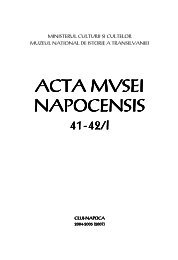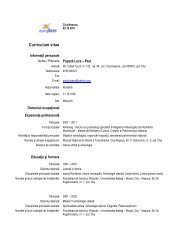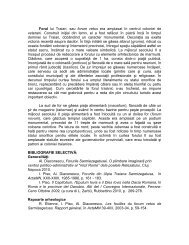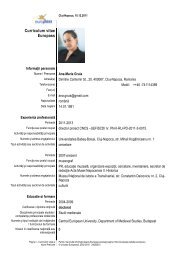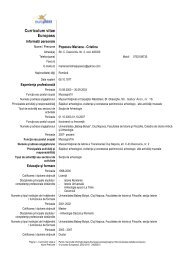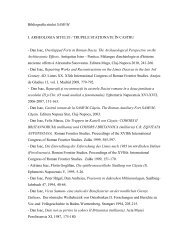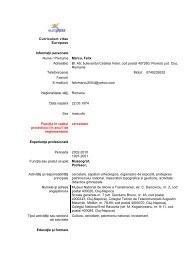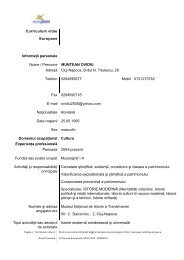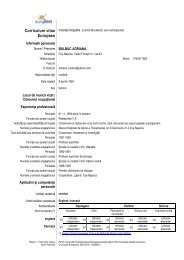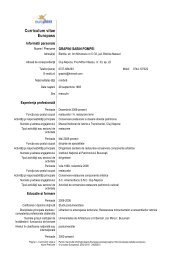43-44/I – Archeology - Muzeul Naţional de Istorie a Transilvaniei
43-44/I – Archeology - Muzeul Naţional de Istorie a Transilvaniei
43-44/I – Archeology - Muzeul Naţional de Istorie a Transilvaniei
Create successful ePaper yourself
Turn your PDF publications into a flip-book with our unique Google optimized e-Paper software.
50<br />
Mihai Rotea et alii<br />
segment of the Someşul Mic river, from its origins to the confluence with the<br />
Nadăş river and the affluent flowing into it from the right: Feneşului, Vulpii,<br />
Sânaslăului, TăuŃului (Boşorului), Gârbăului Valleys. Good quality ground water<br />
reserves are significant, both in the alluvial beds of the Someş river and its<br />
affluent, and in <strong>de</strong>pth, especially in the coarse limestone beds, where the quality<br />
increases consi<strong>de</strong>rably.<br />
Flora and fauna are typical of hill and mountain regions.<br />
The Bronze Age<br />
The Bronze Age is one of the periods abundantly represented in the finds<br />
from the archaeological investigation at Floreşti-Polus Center, be they from the<br />
Early, Middle or Late period.<br />
For the Early Bronze Age, noteworthy in this context are the finds<br />
belonging to the CoŃofeni 6 culture, represented in the investigated area by a few<br />
isolated archaeological complexes, which will be published in <strong>de</strong>tail in the near<br />
future. Among these, a few stand out in sector K5, placed along a precinct road<br />
(Pl. 2). From the very beginning, it is important to make the precision that this is<br />
not a compact cultural layer belonging to this culture, but a settlement of<br />
temporary character, characterized by heaps of archaeological material found at a<br />
distance from one to another. An i<strong>de</strong>ntical situation has been encountered in Deva-<br />
Lenin Str. 7 . The pottery, which makes most of the archaeological material<br />
unearthed is mostly un<strong>de</strong>corated and belongs to the coarse and semi-fine pottery<br />
categories. From a typological viewpoint, the following must be mentioned:<br />
amphoras, large bowls, jars, two-handle pots and cups (Pl. 4<strong>–</strong>12). The ornaments<br />
are mostly ma<strong>de</strong> by wi<strong>de</strong> and <strong>de</strong>ep incisions creating the impression of grooves;<br />
also, impressed <strong>de</strong>corations and appliqué ribs are the most typical (Pl. 4<strong>–</strong>12). They<br />
are arranged as hatched bands, buried triangular frames, “fir leaf” etc. (Pl. 4<strong>–</strong>12).<br />
All these elements indicate the presence of an early stage in the evolution of the<br />
CoŃofeni culture. Several sites belonging to the 1st stage of the CoŃofeni culture<br />
6 The dating of this culture has been drawing the attention of specialists, and no consensus has<br />
been reached up to the present moment. For some elements, see: P. Roman, Cultura CoŃofeni,<br />
Bucureşti 1976, with bibliography; M. Rotea, ContribuŃii privind bronzul timpuriu în centrul<br />
<strong>Transilvaniei</strong>, Thraco-Dacica 14, 1993, 65<strong>–</strong>86; H. Ciugu<strong>de</strong>an, Eneoliticul final în Transilvania şi<br />
Banat: cultura CoŃofeni, Timişoara 2000, with bibliography.<br />
7 M. Rotea, Locuirea CoŃofeni <strong>de</strong> la Deva-Strada Lenin, Sargetia 20, 1987, 475<strong>–</strong>479.



